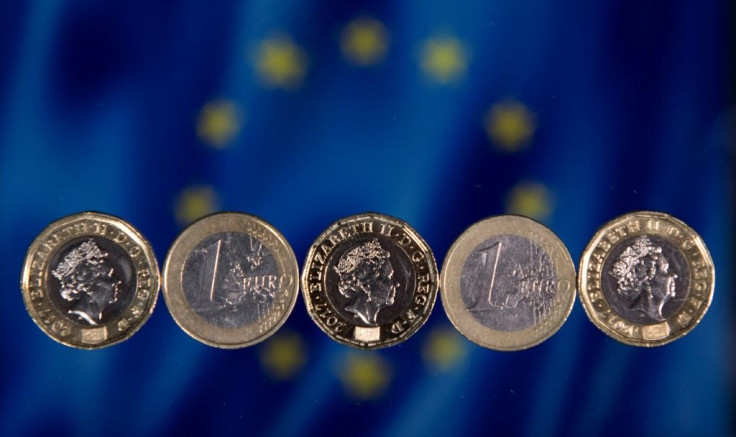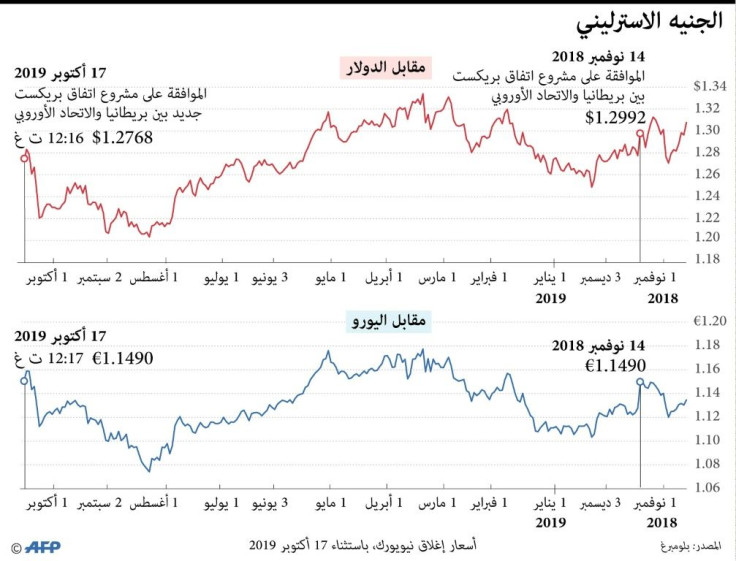Dizzying Times For The Brexit-driven Pound

Five-month highs and frequent falls versus the dollar and euro -- the British pound is at its most volatile in a year, dragged in different directions by Brexit twists and turns.
Thursday was just the latest chapter in sterling's rollercoaster ride, when it soared to $1.2990 on news of a new draft Brexit deal, only to fall back heavily on signs that the exit deal could still be voted down by Britain's parliament.
"Having been anchored solely by Brexit sentiment for many months, the pound's position is now extremely choppy as the market struggles to find equilibrium amongst the chaos," OFX analyst Sebastien Clements said Thursday after sterling had hit the highest levels against the dollar and euro since May and before its fresh slide.
A no-vote by parliament could lead to a postponement of Brexit beyond the October 31 due departure date.
Last week sterling soared nearly 4.0 percent versus the dollar and 3.0 percent against euro over two days, driven by hopes of a deal.

These are huge gains for the foreign exchange market, where hundreds of billions of pounds are traded daily, with the massive currency flows often smoothing out overly volatile moves.
No 'normal' times
But then, with optimism of there being a deal fading over the weekend, the pound proceeded to slide versus its main rivals, before reaching fresh five-month highs over the past three days as sentiment turned positive once more.

Over the past week, sterling has surged around 4.7 percent against the dollar and 3.4 percent versus the euro.
But the British currency is still nowhere near to where it was before the June 2016 referendum.
It now stands 13 percent down on the dollar and 11 percent lower versus the euro compared to its levels before the vote in favour of leaving the EU.

In "normal" times, the pound is driven primarily by monetary policy and economic indicators but for months there has really just been one game in town: Brexit.
Last month, sterling slid below $1.20 for the first time in nearly three years -- reaching its lowest level since 1985 except for a 2016 "flash crash".
A tale of weakness
The pound is a far better indicator of Britain's economic health than the London stock market which is loaded with multinational companies earning mostly in dollars.
And despite recent strong gains, the story of the pound over the past three-plus years has been one of weakness.
Its loss of value has resulted in higher import costs, which in turn help push up inflation.
The Bank of England would ordinarily look to hike interest rates to put a lid on rising consumer prices, but Brexit uncertainty has caused it to sit tight.
Its key lending rate stands at just 0.75 percent.
On the plus side, the weaker pound boosts exporters, whose goods and services become cheaper for those buying in stronger currencies.
Analysts meanwhile expect the pound's wild swings to continue, at least in the near term.
"The volatility in the pound and the UK markets won't stop here," City Index senior market analyst Fiona Cincotta said Thursday.
"This is just half the battle. Pound traders will now turn their attention to the chances of (Prime Minister) Boris Johnson's Brexit deal making it through parliament."
© Copyright AFP 2024. All rights reserved.





















